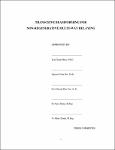| dc.description.abstract | In this thesis, we consider a wireless relay network where a half-duplex multi- antenna relay station (RS) assists multiple communication nodes. Each node has a message and wants to exchange the messages from all other nodes in its group. In such a multi-way relay channel, the communication can only be performed through the RS since it is assumed that there are no direct links between the communication nodes.
Due to the half-duplex constraint, there is a higher number of time-frequency communication resources needed compared to the full-duplex relay station case. The required number of communication phases is determined by the maximum number of nodes. In the first communication phase, the multiple access (MAC) phase, all nodes transmit their data streams simultaneously to the RS. After performing signal processing, in the remaining communication phases, the broadcast (BC) phases, the RS transmits to the nodes by ensuring that each node receives the intended data streams from its communication nodes.
We only consider non-regenerative RS for relaying. A non-regenerative RS performs transceive (transmit and receive) beamforming to the received signals according
to the chosen BC strategy and transmits the output to the nodes. We study a unified system model for non-regenerative multi-way relaying and derive the sum rate expression of non-regenerative multi-way relaying for symmetric traffic. We address tranceive beamforming maximizing the sum rate expression of non-regenerative multi-way relaying. Due to the high complexity of finding the optimum transceive beamforming maximizing the sum rate, we design generalized low-complexity transceive beamforming algorithms for all BC strategies with two different optimization criteria, namely, zero forcing (ZF) and minimization of mean square error (MMSE), and Null-space based schemes (Vector Selection and Coherent Combining). Through this thesis project, we use Matlab software to simulate the results and compare the performances of optimization tranceive beamforming algorithms for the maximizing sum rate and the symbol error rate. | en_US |


